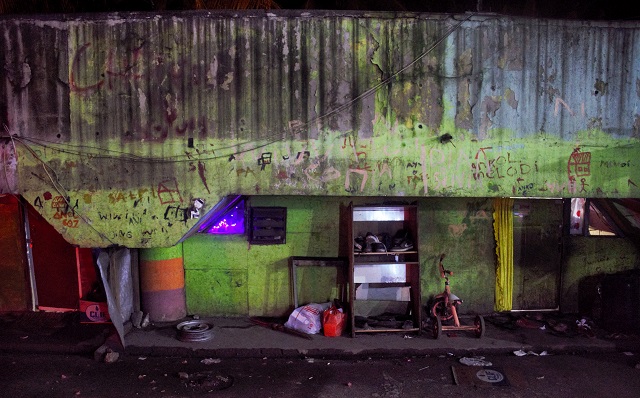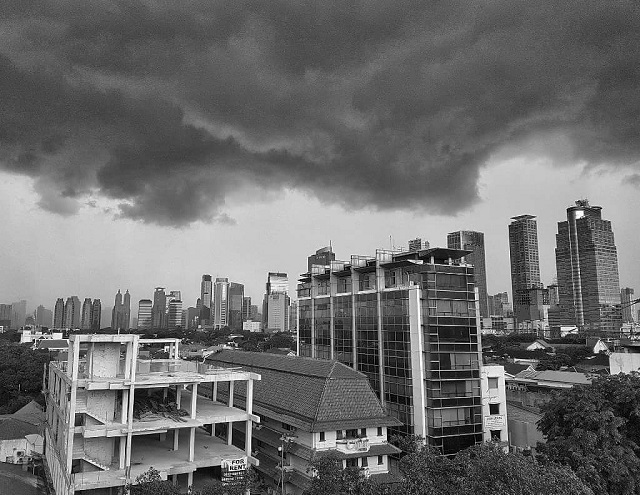Anyone who has spent time in Jakarta will know it as a city of extremes. On the one hand, skyscrapers with mirrors for windows tower over traffic jams in the central business district. On the other hand, kampung dwellers live day to day and find their homes and livelihoods under threat from urban planning and flood alleviation projects. In between lies a growing middle class seeking comfort in shopping malls, fuelling demand for goods and services, and driving the rising number of cars on the roads. Although it’s a vibrant city, not everyone can access what’s on offer.
Over the past few decades, the city has expanded to functionally include satellite cities to the west, east and south, forming the greater city of Jabodetabek (Jakarta, Bogor, Depok, Tangerang and Bekasi). With residents regularly commuting in and out of the central business district, the stress on transportation systems and housing is expanding ever outwards. There have even been suggestions the national government should be moved away from Jakarta to alleviate the pressures of overcrowding. While this is unlikely to happen any time soon, the debate continues to simmer in the background as the central government considers its role in solutions to Jakarta’s problems.
Challenges for infrastructure
Infrastructure (very simply defined) is comprised of the physical and organisational structures required for society to operate. If we take this as our basis for exploring the challenges in Jakarta, then we are talking about a myriad of systems, both in the built environment and in how the city is governed. They can be formal or informal; regulated through top-down edicts or created through bottom-up organising. Infrastructure is shaped by the society that makes it but also feeds back into that society by privileging some groups while excluding others.
Many of Jakarta’s infrastructure issues stem from a failure to implement urban planning and design strategies following independence. Poor implementation (caused by inertia, corruption and lack of capacity) and lack of agility in responding to new challenges has left Jakarta unprepared to accommodate its current population. Though there are many issues, the main ones relate to traffic, flooding and housing – three problems with a clear link to infrastructure and to each other.
Terrible traffic as well as insufficient public transport are perhaps the most visible problems. Who hasn’t spent hours in a car trying to get from A to B? Indeed, most Jakarta residents are resigned to the fact that macet (traffic jam) is part and parcel of life and simply has to be factored into daily routines. But just because people work around it does not mean they aren’t dissatisfied with the status quo. In 2017, Jakarta was rated the eighteenth most stressful city in the world (just ahead of Kolkata, India) because of its traffic woes. And the pollution created by car emissions poses a verifiable risk for public health.
Belatedly, a multitude of projects have been launched to address the problems, including the construction of a Mass Rapid Transit (MRT) rail line. The project’s first phase ought to be completed in 2019, and will link Lebak Bulus in the south-west to the Hotel Indonesia Roundabout in the city centre. The MRT is meant to reduce the number of cars on the roads, but sceptics urge caution – they are weary of big promises and spectacular failures like the Jakarta Monorail (started in 2004, abandoned in 2008, revived in 2013 and abandoned again in 2015, due to financial difficulties).
While flooding tends to be a seasonal issue (the rainy season is around October to April), rising sea levels have made the problem more frequent and acute. There are even concerns that Jakarta is sinking, and that more than 40 per cent of the city is already underwater. Attempts to address the issue have included mass relocations that have been very unpopular with some residents, especially those mostly poor people who had close ties to the land and communities they were forced to leave.
Housing issues are less well-known and more complex. Many of Jakarta’s middle class families are turning to high-rise living, with implications for how resources are used and putting further pressure on existing infrastructure. The availability of affordable housing is decreasing with rapid urban growth, particularly for the urban poor who find themselves increasingly pushed out to the margins of the city. Housing and population pressures also have a flow-on effect for the environment. For instance, almost 50 per cent of residents do not have access to piped water, instead relying on wells for their needs, which drains the local aquifer and further causes Jakarta to sink.
Infrastructure as politics
Citizens of Jakarta elected a new governor in 2017, and while the elections were controversial for a range of religious and ethnic reasons, infrastructure issues also played a role. Incoming governor Anies Baswedan and his deputy Sandiaga Uno beat their high-profile opponent, former governor Basuki Tjahaja Purnama. Also known by his nickname, Ahok, he had a reputation for ‘getting things done,’ including projects to reduce traffic congestion and flooding. However, this was counterbalanced by reactions to the drastic measures he sanctioned, including forced relocations, to make way for the infrastructure projects. There has been speculation that his electoral loss was at least partially tied to his support for evictions.
The changeover in leadership made people feel uncertain about whether the new government would head in the same direction. But the current gubernatorial team has made a point of demonstrating its commitment to improving Jakarta, not least because it is nearly impossible to ignore the city’s infrastructure challenges. They have inherited all kinds of problems, including delayed infrastructure projects, but have also used infrastructure issues as a means for generating support among voters. In November 2017, for example, Sandiaga claimed he would use a visit to Dubai as an opportunity to attract new foreign investment for much needed infrastructure projects.
The new leadership team have also floated a number of populist infrastructure policies, including reintroducing becak (pedicabs) to the streets of Jakarta, which were outlawed in 2007. Invoking nostalgia for becak, the team touted them as an environmentally friendly mode of transport and a current world wide trend. The governor and his deputy also closed off roads around the popular markets of Tanah Abang in Central Jakarta to accommodate street vendors. This turned out to be a planning gaff, as mounting congestion led to traffic police calling on the governing team to rethink their decision.

Jakarta’s infrastructure issues will inevitably find themselves under a global spotlight when the Asian Games commence in August 2018. While the Sports Ministry claims that construction of the sporting venues will be completed in time, there remain doubts about whether Jakarta’s infrastructure can support the expected influx of 3 million visitors. The added pressure will be somewhat alleviated by the fact the games are being co-hosted with the Sumatran city of Palembang. However, there is still real potential for embarrassment if Jakarta’s infrastructure failures are broadcast to the world. We will see talk about its successes and failures again in the lead up to the 2019 presidential election.
In this edition
This edition of Inside Indonesia brings together contributions that highlight challenges in addressing Jakarta’s extensive infrastructural problems, especially for those who are marginalised from decision-making. We open the edition with an article by Amalinda Savirani and Ian Wilson, who discuss the hardships of people forcibly relocated from an ‘illegal’ settlement to rusunawa – Indonesia’s multi-storey social housing buildings. The move has meant much more than simply a new address, as the physical layout and management of the rusunawa disrupt the residents’ social bonds and economic livelihoods. Following this we turn to transportation issues with an article by James Guild, which considers difficulties in designing and implementing successful solutions for Jakarta’s congested roads. Rémi Desmouliere and Fariz Panghehar then tell us how government-owned public transport operators like TransJakarta – which increase options and comfort for commuters – are having a negative impact on privately employed minibus drivers.
We also explore issues of accessibility. Traci Sudana writes about the provision of informal healthcare via the unauthorised sale of medicine. Poverty, inequality and inaccessibility sometimes force city dwellers to shop by the roadside for medicine, rather than go without. Meanwhile, Bahrul Fuad examines the difficulties people with disabilities face getting around Jakarta; in the government’s rush to improve infrastructure, people with disabilities are getting left behind, unable to make full use of bus routes and footpaths. Finally, an interview by Wayne Palmer with Koalisi Pejalan Kaki (Walkers’ Coalition) looks at how Jakarta could become more pedestrian-friendly to encourage more people to walk instead of using vehicles.
The perspectives offered in this edition present a side of Jakarta that you are unlikely to read about or hear Governor Baswedan refer to. They highlight the complexity of the infrastructure problems, and the fact that proposed solutions do not always bring wholly positive changes.
Elisabeth Kramer (elisabeth.kramer@sydney.edu.au) is the deputy director of the Sydney Southeast Asia Centre at the University of Sydney.
Wayne Palmer (wpalmer@binus.edu) is a lecturer in the Department of International Relations at Bina Nusantara University.
